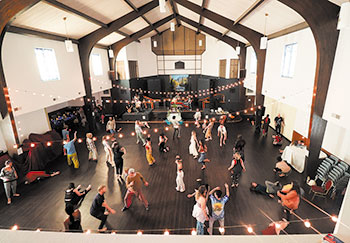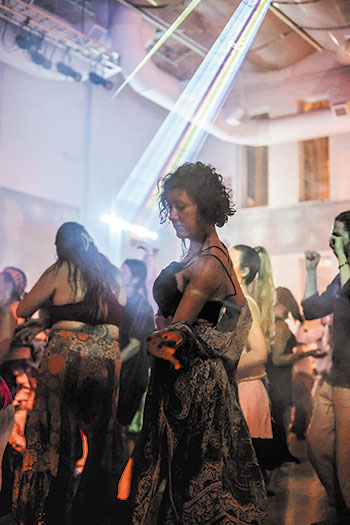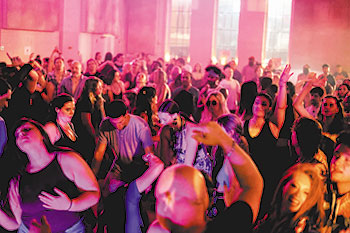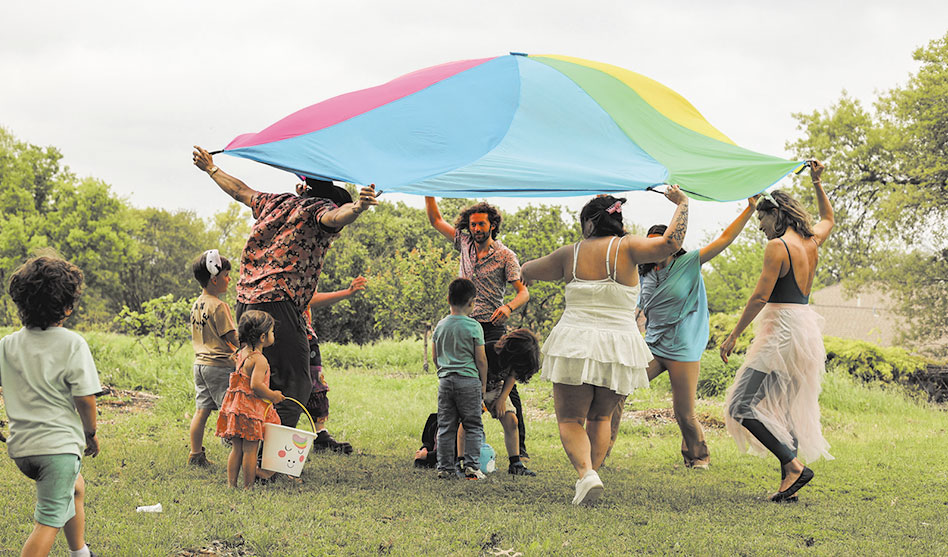DMC offers queer people a place to dance outside of the bar scene
CAROLINE SAVOIE | Contributing Writer
CaroSavo@gmail.com
In an old church with a new purpose, a group of self-proclaimed “weirdos” gather on Sundays to worship and engage in ceremonies, outside of religion. They gather to celebrate life’s highs and lows, the dark and the light, through dance.
The Dallas Movement Collective gathers to embody all that is seen and unseen.
Some dancers in the LGBTQ community have found that through somatic embodiment practices, growing the connection between the body and the mind, they’ve been able to get in touch with their queernness in new ways. Peyton Baker, a 30-year-old artist and feminine embodiment coach, said that through dancing with the collective since 2016, she’s found a new ability to take up space as a queer woman.
 “Besides finding my first real girlfriend there, the dance offers a space of acceptance and non-judgement,” Baker said. “At dance, I’m allowed to take up space and express my queerness through dancing with other women.”
“Besides finding my first real girlfriend there, the dance offers a space of acceptance and non-judgement,” Baker said. “At dance, I’m allowed to take up space and express my queerness through dancing with other women.”
Stephanie St. John, a queer 48-year-old yoga, energy and somatic worker, said she’d been dancing for years before she found the movement collective. When she found DMC, she felt like she “found her people.” She’s been with the group for nine years.
In New York and Boston, dances are popular spaces for queer people to meet up and express themselves, especially around Pride events, St. John said.
“A lot of queer kids are dance kids,” she said. “Spaces that are open to sensuality, that allow you to dress and present yourself however you want, draw our kind in — and for good reason.”
The self proclaimed “punk rock queer” said she can dress really feminine or “shave [her] head and wear [her] flannel and rock [her] chains” at dance.
“Every version of life is represented at dance,” St. John said. “It’s a beautiful thing.”
Baker said that at first, she was hesitant to “come out” to people in the collective because she specializes in womens’ embodiment, and she didn’t want people to think that just because she was attracted to women that she was hitting on the women she works or dances with.
“Now I realize how silly that is and how little people care who I’m attracted to,” Baker said. “It’s freeing to be openly queer and provide a space for other women, especially queer women, in my work and through dance.”
 Darrin Davis, a 54-year-old gay artist and performer, said he felt the same way Baker did when he started dancing with the collective. He was protective of his sexuality because he thought keeping his gayness a secret would protect others.
Darrin Davis, a 54-year-old gay artist and performer, said he felt the same way Baker did when he started dancing with the collective. He was protective of his sexuality because he thought keeping his gayness a secret would protect others.
“I wanted to share a dance with other men without them thinking I was being creepy,” he said. “Now that I’m being authentically myself, people see me more than they did before. Now I share dances with straight people, and we find a dance through our shared masculinity.”
SolAmor Heumada Ildefonso, a 43-year-old who identifies as two-spirited, gay/bisexual and polymonogamous, said she faced similar hesitance in discussing her sexuality with people in the DMC community. “Before finding community, I faced ridicule and judgment, and I was hesitant to come out because of fear of rejection,” she said. “But when I heard people talking about being poly[amarous], it made me feel safer, like I wasn’t the only one.”
She said she casually found herself making comments about gayness in conversation, and “I felt that in those conversations, I was able to discuss my worldview, the way I love, in a space of non-judgment.”
Davis said although many people in the collective are LGBTQ, he yearns to see more gay men in the space. He said DMC offers gay people a space to explore
acceptance in an environment shared with straight folks.
“It gives people a chance to dance in a space that might be more neutral than super gay, a space outside of Cedar Springs,” he said, referring to Dallas’ gayborhood.
He said that the movement collective’s agreements for the space — to be sober, non-verbal, barefoot, vulnerable and without cell phones — offers LGBTQ people an avenue to the ecstatic outside of the clubs and bars.
“The club scene and party circuit are so ingrained in the gay community, but getting to explore dance without having to have a couple drinks in you first helps you heal and grow in a different way,” Davis said. “Most of our lives are lived in a sober space, so connecting with people without the extras is important.
“Over time, people you meet give you different connections than you get out in a club.”
St. John said presenting a sober space to the LGBTQ community is asking people to move in a way they’re not used to.
“There’s a learning curve there, and it can be uncomfortable at first. But I think our people are ready for it,” she said. “Be open to reprogramming, to learn what goes on in your tissues, what needs to be birthed, and give it some space.”
 Kelly Harrod is a 32-year-old non-profit operations manager who identifies as bi/pansexual. She found the DMC two years ago, and it’s been “a pivotal part” of her healing and sobriety journey. She said she learned about the DMC from someone in her Alcoholics Anonymous group.
Kelly Harrod is a 32-year-old non-profit operations manager who identifies as bi/pansexual. She found the DMC two years ago, and it’s been “a pivotal part” of her healing and sobriety journey. She said she learned about the DMC from someone in her Alcoholics Anonymous group.
“At first I just showed up to dance with no want or need for the community aspect,” she said. “But over time I have come to see dance as not only a movement practice but a spiritual and community practice just like going to church was as a child.”
Baker said she danced in clubs professionally before she found the movement collective, and it has helped her explore sobriety and sexuality in a safe, embodied way.
“I got to find my own dance instead of dancing for others, especially men,” she said. “Instead of dancing for someone else’s pleasure, I was dancing for my own pleasure.”
Both Davis and Baker said meeting queer people and allies through DMC has given them some of their most fruitful friendships.
“At dance, I don’t have to wear a mask,” Baker said. “And that has helped me make the most authentic friendships I have. People there are just as weird as me, and they see me as a human first and foremost. Labels are thrown out the window when you’re in a non-verbal space. Any space that supports dudes wearing skirts and women dancing sensually is a space that supports queer expression.”
Ildefonso said that at dance, labels aren’t the most important thing about her, and she doesn’t feel like she has to exist within the confines of a label. “It’s an open and free space welcome to all, a space where I could just be me and shed all the labels,” she said. “At dance, it’s just ‘come as you are, all of you is welcome here.’”
Baker said there’s no threat of being harassed at dance, both because the space is non-verbal and because leadership will remove anyone who doesn’t respect dancers and consent.
“The agreements around consent allow us to honor our ‘yes’ and our ‘no’,” Baker said. “If you don’t want to dance with someone who wants to dance with you, it’s totally okay to stay in your own dance and explore there.”
St. John said she learns more about herself through every dance, through listening to her body’s inherent wisdom. “When the space is non-verbal, all you can do is listen and feel, and that’s valuable.”
Victoria Aris, a bisexual 35-year-old personal spirituality coach who identifies as genderfluid, said she’s been doing ecstatic dance since she was a teenager. Now, almost a year into her journey with DMC, she said it has heavily impacted her life.
 “Dance laid a foundation for me to get in touch with my own inner world, to learn how to express myself and feel free in the moment,” she said.
“Dance laid a foundation for me to get in touch with my own inner world, to learn how to express myself and feel free in the moment,” she said.
When Aris was growing up, she said, she heard about different queer experiences and was interested in exploring. She took the foundation dance gave her and built upon her identity.
“The movement collective found me at just the right time,” she said. “It gave me a period of release. It allows me to tap into moving in a way that feels right to me outside of gender norms and compulsory heterosexuality.”
Sarah Sampson, executive director of DMC, said she’s personally been someone people “come out” to, which she considers an honor and source of joy.
“There have definitely been people who come out through their journey with ecstatic dance,” she said. “This space is a place where they can begin to experiment with dressing how they want to dress, using the pronouns and names they want to use. We’re an incubator where people can try on embodying truer parts of themselves before bringing that out into the larger world.”
Baker, Harrod and Davis said they feel like their voices are heard, included and celebrated in the DMC. St. John, who leads the movement collective’s BIPOC dance, said she felt like in the past, her voice may have fallen on deaf ears, but now she feels comfortable to speak up, like her input will be valued.
“If you fell out of dance for one reason or another, I always suggest trying it again,” she said. “I really love the direction the collective is moving in.”
Aris said she feels trusting of not only the people at dance, but of Sampson and her leadership style: “I know if I ever need to talk to anyone about something I experience, Sarah will lend her support.”
Sampson, who considers herself an ally, said overall, the DMC is designed, curated and cultivated so people can drop what’s different and hone into the common spaces of body and breath.
“The deeper layers of the dance also get into the idea that we all share the land and the planet,” she said. “No matter who we love, how we love, where we come from, where we’re going, there’s a deep common humanity that binds us together.”
She said while common ground is valued, the other side of that coin is individuality.
“The space is also there to give people the ability to express their uniqueness, to practice and unleash the expressions in the body and in the voice that in the past may have been criticized, judged or met with cruelty and violence,” she said. “I think the space gives people of all genders the opportunity to express how they feel on the inside.”
Sampson was 13 when she lost her transgender aunt to suicide, and it had a huge impact on her. She wants queer youth to feel like there’s a safe space for them, especially in Texas.
“It’s fucking life or death in some of these situations for queer people in the South who feel unsafe,” she said.
Harrod said her family growing up was very homophobic, and her parents wouldn’t let her or her siblings “do or see anything that may be perceived as gay,” Harrod said. But DMC and ecstatic dance practices have helped her be more open in her queer expression, experiment with her fashion and be open to shaving her head.
Aris said her gender expression moves and flows like the dance. “I can flip through the stages of my expression and move through the kaleidoscope of everything I am all in one cohesive experience — dance!” Aris said.
Harrod said that many queer people have unhealthy relationships with their bodies, and dance can help “sort that out.”
St. John said that she’s seen dance help people release shame in their bodies, and that has a cascading effect that helps release shame about other things, like sexuality and sensuality.
“It’s a space of intersectionality where you learn that it’s safe to play,” she said “Invite yourself there, and mine whatever comes up for you. You can do all types of therapies, but the dance is the space where you go to integrate. You can talk all you want, but if the body isn’t online, it’s much harder to integrate your emotions.”
Davis said emotions of all sorts are accepted on the dance floor.
“People are dancing for all different reasons — grief, joy, passion, trauma, healing — it’s all welcome in ecstatic dance. That kind of environment is invaluable for gay people.”
Aris said if she were speaking to a queer person interested in dance, she would prepare them to feel overwhelmed or uncomfortable with the radical freedom they would feel at dance.
“Be prepared to feel radically accepted, not just through dance, but with the overall atmosphere,” she said. “Freedom can feel uncomfortable or overwhelming, and you may cry. But slowly, you’ll feel your heart start to open up and rest in the acceptance of a loving community. You’ll peel back layers of yourself you didn’t know existed.”
St. John said queer people need spaces like the ones DMC provides. “With all of our brothers and sisters who have died of suicide and struggle with addiction, we need spaces like dance: safe spaces, brave spaces,” she said.
For more information visit DallasMovementCollective.com.


